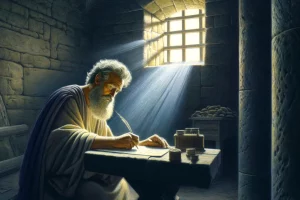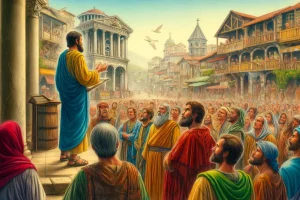
The Book of Ezekiel
The Book of Ezekiel is a significant prophetic text in the Old Testament, characterized by its vivid visions and the profound messages conveyed by the prophet Ezekiel. Here are some key facts about the Book of Ezekiel:
- Author and Prophet: Ezekiel, a priest from the line of Zadok, is the author and central figure of the book. He was among the Jews deported to Babylon during the first captivity in 597 BCE.
- Date and Location: The prophecies of Ezekiel were given between 593 and 571 BCE, during his exile in Babylon.
- Structure: The book contains 48 chapters, which can be divided into three main sections: prophecies against Israel (chapters 1-24), judgments against foreign nations (chapters 25-32), and prophecies of hope and restoration (chapters 33-48).
- Key Themes:
- Divine Judgment: Ezekiel discusses the reasons for God’s judgment against Judah and Jerusalem, primarily their idolatry and unfaithfulness.
- Individual Responsibility: Ezekiel emphasizes personal responsibility and the need for individual repentance.
- Restoration and Renewal: Despite the harsh judgments, Ezekiel offers a message of hope, forecasting the restoration of Israel and the renewal of the Temple.
- Famous Visions:
- The Vision of the Four Living Creatures and the Wheels (Chapter 1): This is one of Ezekiel’s first visions where he sees heavenly beings with four faces and wheels within wheels, filled with eyes around their rims.
- The Valley of Dry Bones (Chapter 37): Ezekiel prophesies over a valley of dry bones, which come to life as an illustration of Israel’s restoration.
- Theological Contributions: Ezekiel contributes significantly to Jewish theology, including ideas about the Shekinah (God’s presence) leaving and returning to the Temple, and the concept of a new heart and new spirit within the context of a new covenant.
- Literary Style: Ezekiel’s use of allegory, symbolism, and apocalyptic visions distinguishes his prophetic style, making it both complex and richly illustrative.
- Historical Impact: The book has had a profound impact on both Jewish and Christian eschatology and has been influential in various aspects of religious thought and practice, including ideas about the end times and the Messianic era.
The Book of Ezekiel stands out in the Old Testament for its complex symbolism, detailed prophecies, and intense visions. Written by Ezekiel, a priest turned prophet during the Babylonian exile, this book bridges the tumultuous period of Jerusalem’s fall with the hopeful promises of restoration. Here is a comprehensive analysis of the Book of Ezekiel, covering its structure, themes, and theological significance.
1. Structure and Composition
The Book of Ezekiel is divided into several sections, reflecting a progression from judgment to restoration:
- Chapters 1-24: Focus on oracles of judgment against Jerusalem and Judah, with vivid descriptions of the reasons for God’s impending punishment.
- Chapters 25-32: Contain oracles against foreign nations, expanding the scope of Ezekiel’s prophecies to the international stage.
- Chapters 33-48: Shift towards messages of hope and restoration, including the famous vision of the Valley of Dry Bones and the detailed plans for the new Temple.
2. Key Themes
- Divine Glory and Human Responsibility: Central to Ezekiel’s message is the concept of God’s glory and sovereignty juxtaposed with human responsibility. The departure of God’s glory from the Temple is a pivotal event, symbolizing the loss of divine protection due to the people’s sins.
- Judgment and Restoration: Ezekiel provides a thorough explanation of the reasons for Jerusalem’s destruction, emphasizing that divine judgment is not capricious but a response to Israel’s persistent idolatry and ethical failures. However, the promise of restoration and renewal is equally prominent, offering hope for a future reconciliation between God and His people.
- New Covenant and Individual Responsibility: Ezekiel emphasizes that individuals are responsible for their actions, a shift from corporate to personal responsibility in the relationship with God. He also speaks of a new covenant, marked by a new heart and a new spirit, foretelling a deeper, more spiritual rebirth of the people.
3. Visionary Prophecies
Ezekiel’s method of conveying his messages through dramatic visions and symbolic actions sets him apart. Notable visions include:
- The Vision of the Chariot (Chapter 1), which illustrates God’s mobility and omnipresence.
- The Valley of Dry Bones (Chapter 37), symbolizing the revitalization of Israel.
- The New Temple Vision (Chapters 40-48), which outlines a meticulously detailed vision of a new, idealized temple, signifying the full restoration of the divine presence among the people.
4. Theological Contributions
Ezekiel’s theological insights are profound, particularly his contributions to Jewish concepts of the presence of God (Shekinah), the spirit, and the heart. He portrays God as transcendent yet imminent, capable of punishing but equally ready to restore and dwell among His people once again.
5. Historical and Cultural Context
Written during and after the catastrophic destruction of Jerusalem in 586 BCE, Ezekiel’s prophecies reflect the challenges and realities of the Babylonian exile. His messages are tailored to an exiled community, struggling to maintain their identity and faith away from their homeland.
6. Literary Style
Ezekiel’s style is complex, characterized by the use of allegory, repetition, and detailed symbolic actions. His narrative technique—often involving direct address and dramatic enactment—serves to engage, admonish, and ultimately offer solace to his audience.
7. Enduring Relevance
The book’s exploration of themes like divine presence, judgment, individual responsibility, and hope for restoration continues to resonate. Ezekiel’s visions, particularly of the new Temple, have influenced Jewish and Christian eschatological thoughts and have been pivotal in various interpretive traditions regarding the end times.
In conclusion, the Book of Ezekiel offers a rich tapestry of prophetic traditions, combining vivid imagery, moral instruction, and eschatological promise. It challenges its readers to reflect on personal responsibility while reassuring them of God’s unending commitment to His covenant.



